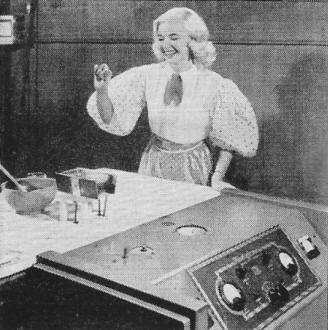|
Little known to most
people (including moi until recently),
De Forest Training School
was started by DeVry University's founder Herman A. DeVry. DeVry and De Forest were
DeGood DeFriends, leading DeVry to name his electronics school after De Forest.
It was re-named DeVry Technical Institute in 1953. Research at De Forest Training
School produced one of the first RF / microwave food baking "oven." The prototype
reported in this 1951 Radio & Television News magazine article was
not at all like modern microwave ovens. There was no enclosure into which baking
bowls, pans, and dishes can be inserted. Rather, electrodes were arranged at the
perimeters of the special pan that in this demonstration contained cake batter.
It was adapted from a process originally developed for
RF induction heating of industrial materials (a major source of RF interference
in the early days). A 10 MHz signal from a 1 kW generator provided the
energy needed to bake an off-the-grocery-shelf cake mix in just 90 seconds.
Cakes Baked in 90 Seconds - Early Microwave Oven
 By George Petchel By George Petchel
Industrial Electronics Dept., DeForest's Training. Inc.
"Sounds fantastic, doesn't it? - well, it is!"
So stated a newspaper reporter at the scene of a 90-second cake baking demonstration
conducted in the laboratories of DeForest's Training, Inc., 2735 N. Ashland Ave.,
Chicago, Illinois.
A batter made from a nationally-known cake mix plus plain water was poured into
an ordinary Pyrex baking dish. This was placed between two vertical electrodes fastened
to a polystyrene base and mounted on top of a kitchen table. The electrodes were
connected by means of copper tubing to a radio frequency generator located nearby.
The batter turned into the kind of cake Mother used to make, not in 45 minutes, not in 10 minutes, but in 90 seconds! However, this feat was not accomplished
without some measure of research and toil by students and instructors.
Flat aluminum electrodes were first used, but difficulty was encountered in obtaining
the correct concentration of electric field and were later supplemented with ordinary
aluminum foil. The foil was affixed to two opposite sides of the baking dish and
then cut and shaped to form a field which gave best results.
Thickness of the batter also determined the quality of the cake. A thick batter
baked more slowly and caused arcing between batter and electrodes. This cake was
heavy and had burned spots. A batter which was quite fluid gave fine results and
produced a cake that was light and tender with excellent texture and flavor qualities.
With this type of batter little or no arcing was encountered and baking time was
reduced to a minimum.
The demonstration was performed with a Westinghouse 1 kilowatt radio frequency
generator designed especially for schools and laboratories. The unit has two radio
frequency outputs. Its low frequency is at 300 kilocycles per second, suitable for
experiments in induction heating. Its high frequency output at 10 megacycles per
second is for experiment and study in dielectric heating. The latter is the frequency
at which the cake baking was done.
Materials suitable for radio frequency heating are determined by their electrical
properties. If the material is an electrical conductor, either magnetic or non-magnetic,
it can be heated by means of its own I2R losses due to currents induced
in the material when it is placed in a varying magnetic field. On the other hand,
if the material is nominally insulating, it is placed in a varying electric field
and will be heated due to its own dielectric losses generated due to the field.
Dielectric heating, a comparatively new technique, employs higher frequencies
than induction heating and is commercially applied to plastics, ceramics, rubber,
wood-bonded products such as plywood, and similar non-conducting materials.
The materials available to the student at DeForest's Training, Inc., are limited
only by his imagination. Electronics' challenge to convention captures his fancy.
Under the stimulation and guidance of the instructors he is encouraged and directed
in the development of his ideas. Students who come to the school from far flung
sections of the country suggest original applications of this new technique. The
drying of hay and corn, curing tobacco, vulcanizing rubber, or cooking and baking
various foods are subjects of experimentation.
What has been done in hours can now be done in minutes - even seconds! To the
unexpected guest it can now be said, "I didn't know you were coming, but I'll bake
a cake anyhow!"
Test setup used to bake cake with r.f.
Posted September 24, 2020
|









